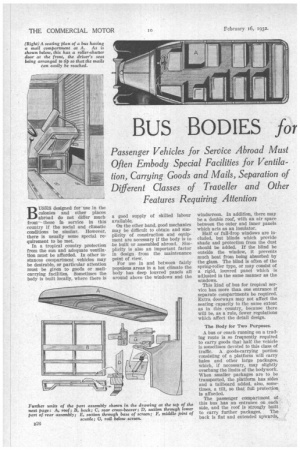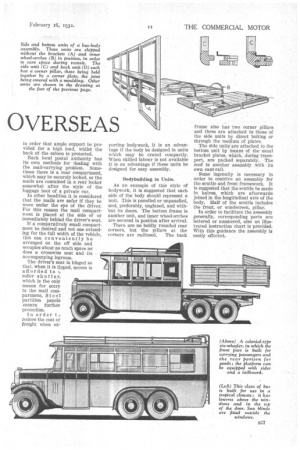BUS BODIES for
Page 44

Page 45

If you've noticed an error in this article please click here to report it so we can fix it.
OVERSEAS
Passenger Vehicles for Service Abroad Must Often Embody Special Facilities for Ventilation, Carrying Goods and Mails, Separation of Different Classes of Traveller and Other Features Requiring Attention
BUSES designed for use in the colonies and other places abroad do not differ much from those in service in this country if the social and climatic conditions be similar. However, there is usually some special requirement to be met.
In a tropical country protection from the sun and adequate ventilation must be afforded. In other instances compartment vehicles may be desirable, or particular attention must be given to goods or mailcarrying facilities. Sometimes the body is built locally, where there is a good supply of skilled labour available.
On the other hand, good mechanics may be difficult to obtain and simplicity of construction and equipment are necessary if the body is to be built or assembled abroad. Simplicity is also an important factor in design from the maintenance point of view.
For use in and between fairly populous areas in a hot climate the body has deep louvred panels all around above the windows and the windscreen. In addition, there may be a double roof, with an air space between the outer and inner panels which acts as an insulator.
Half or full-drop windows are included, but blinds which provide shade and protection from the dust should be added. If the blind be outside the window, it prevents much heat from being absorbed by the glass. The blind is often of the spring-roller type, or may consist of a rigid, louvred panel which is adjusted in the same manner as the windows.
This kind of bus for tropical service has more than one entrance if separate compartments be required. Extra doorways may not affect the seating capacity to the same extent as in this country, because there will be, as a rule, fewer regulations which affect the detail design.
The Body for Two Purposes.
A bus or coach running on a trading route is so frequently required to carry goods that half the vehicle is sometimes devoted to this class of traffic. A goods-carrying portion consisting of a platform will carry bales and other large packages, which, if necessary, may slightly overhang the limits of the bodywork. When smaller packages are to be transported, the platform has sides and a tailboard added, also, sometimes, a tilt, so that full protection is afforded.
The passenger compartment of this bus has an entrance on each side, and the roof is strongly built to carry further packages. The back is flat and extended upwards, in order that ample support be provided for a high load, whilst the back of the saloon is protected.
Each local postal authority has its own methods for dealing with the mail-carrying problem. Sometimes there is a rear compartment, which may be securely locked, or the mails are contained in a rear locker somewhat after the style of the luggage boot of a private car.
In other localities it is considered , that the mails are safer if they be more under the eye of the driver. For this reason the mail compartment is placed at the side of or immediately behind the driver's seat.
If a comparatively small compartment be desired and not one extending for the full width of the vehicle. this can conveniently be arranged on the off side and occupies about as much space as does a crosswise seat and its accompanying legroom.
The driver's seat is hinged so that, when it is tipped, access is afforded to o. roller shut ter, which is the only means for entry to the mail compartment. Steel partition panels ensure further protection.
In order reduce the cost of freight when ex porting bodywork, it is an advantage if the body be designed in units which may be crated compactly. When skilled labour is not available it is an advantage if these units be designed for easy assembly.
Bodybuilding in Units.
As an example of this style of bodywork, it is suggested that each side of the body should represent a unit. This is panelled or unpanelled, and, preferably, unglazed, and with'out its doors. The bottom frame is another unit, and inner wheel-arches are secured in position after arrival.
There are no boldly rounded rear corners, but the pillars at the corners are radiused. The back frame also has two corner pillars and these are attached to those of the side units by direct bolting or through the medium of plates.
The side units are attached to the bottom unit by means of the usual bracket plates, which, during transport, are packed separately. The roof is another assembly .with its own cant-rail.
Some ingenuity is necessary in order to contrive an assembly for the scuttle and front framework. It is suggested that the scuttle be made in halves, which are afterwards joined in the longitudinal axis of the body. Half of the scuttle includes the front, or windscreen, pillar.
In order to facilitate the assembly generally, corresponding parts are lettered or numbered, also an illustrated• instruction chart is provided. With this guidance the assembly is easily effected.




































































































